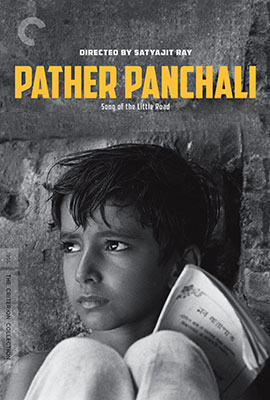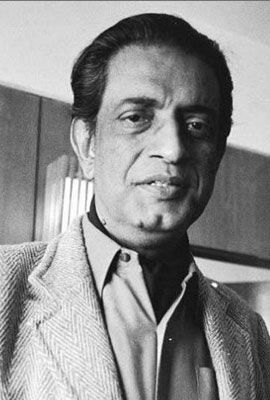
(1955)
directed by Satyagit Ray
My judgment that Satyagit Ray is the world’s greatest filmmaker is not based on an opinion poll but purely on my own feelings. After I watched his movie “Pather Panchali,” I said to myself, “This is the most moving film I have ever seen!” It is impossible to prove that something is beautiful. Still, I felt a need to offer some explanation for what I was feeling. Why is this film so beautiful and why is it so moving?
Ray’s magnificent Apu trilogy creates a world so real that it feels like we have stepped into another life. The three films swept the top prizes at Cannes and created a new cinema for India. The trilogy is based on a famous novel about the life of a young man named Apu. “Pather Panchali” is the first film in the trilogy. The film’s title means “The Song of the Little Road.”
“Pather Panchali” tells the story of Apu’s childhood. He is living with his parents, his older sister, and his very old aunt. His father has brought the family back to the family’s ancestral village despite the misgivings of Apu’s always worried mother. His father is full of ideas and plans which he believes will eventually sustain the family. It is Apu’s mother who worries about money owed to relatives, about food for the children, and about repairs to their home.
The most compelling character in the film is the old aunt, played by Chunibala Devi. Doubled over and deeply wrinkled, she was eighty when shooting began and died shortly after the film was completed. When Apu’s mother gets angry at her and tells her to leave, she goes from door to door in the village asking, “Can I stay?” She has no home and no possessions except for the clothes she is wearing. She accepts her fate without complaint.
The children explore the countryside hoping to catch a glimpse of a passing train. The cinematographer, Subrata Mitra, follows the children in scenes of extraordinary beauty. The camera travels along forest paths, alongside rivers, and records the gathering clouds of an approaching storm. In a particularly beautiful scene, Apu’s sister dances wildly in a downpour. She is full of life in the midst of the storm.
Objects in the film, including the rice container with its slowly diminishing contents, the stolen fruit, Auntie’s new shawl, the stolen necklace, and Durga’s treasure box ground the human drama in the material world. These objects give exquisite meaning to Ray’s film. They communicate the “transience of things.”
“Pather Panchali” is a priceless treasure of world cinema. My heart grew two sizes the first time I watched “Pather Panchali!” The film is deeply moving because it celebrates life while acknowledging the inevitability of death. The Apu trilogy traces the course of a young man’s life from childhood, to coming of age, to marriage, and finally to maturity. The remaining two movies in the Apu trilogy, “Aparajito” and “Apur Sansar,” are discussed in Chapter 8, “Coming of Age.”
Satyagit Ray

Satyagit Ray, the director of “Pather Panchali,” started his career as a commercial artist. He was drawn into film making after meeting the French director Jean Renoir and after seeing Vittorio De Siva’s Italian neorealist film “Bicycle Thieves” during a visit to London.
When Ray started filming his movie “Pather Panchali,” he had never directed a single scene, his cinematographer had never filmed a single scene, and his child actors had never acted. Despite all this inexperience, early footage was so compelling it helped Ray obtain financing for the rest of his movie.
Inexperience may have actually fostered creativity. At the time, movie crews waited for good weather and shut down production if it was raining. Ray followed his instincts and solved problems like how to film in the midst of a rain storm with umbrellas, tarps, and a “must do” attitude.
Ray was the first Indian to receive the Academy Honorary Award for his tremendous impact on film making. Ray was the second film personality after Charlie Chaplin to be awarded an honorary doctorate degree by Oxford University. Ray also received numerous other awards and honors including the Commander of the National Order of the Legion of Honour, the highest decoration in France.
Ray’s genius was matched by his humility. According to the leading actor Babita, “One of the most remarkable experiences working with Satyagit Ray was when one day, while shooting, I had to cross a small bridge on foot. I had to take my slippers off and forgot to pick them up. When I turned around, I was shocked to see that Mr. Ray was carrying my slippers! This was a lesson in humility that I’ll never forget.”
Ray was a hands on director. His script writing and directing were accompanied by his meticulous set and costume designs. He designed the calligraphy for the opening credits, selected the cinematography, composed the music (sometimes in collaboration with composers like Ravi Shankar), and designed the posters for his film releases.
Satyagit Ray was a director of breathtaking talent and breadth. Ray took the earth, the sky, the rivers, and the clouds, introduced his simple, heartwarming stories, and fashioned his characters from the ordinary people of his beautiful country.